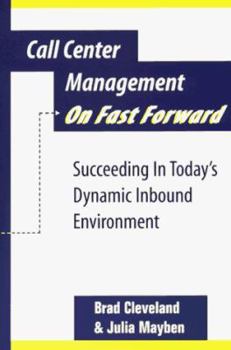Call Center Management on Fast Forward: Succeeding in Today's Dynamic Inbound Environment
Select Format
Select Condition 
Book Overview
Call Center Management on Fast Forward is the most widely read book on contact center/call center management available today. Trusted for its accuracy, clarity and proven guidance, it has become... This description may be from another edition of this product.
Format:Paperback
Language:English
ISBN:0965909301
ISBN13:9780965909303
Release Date:January 1999
Publisher:ICMI Press (International Customer Management
Length:281 Pages
Weight:1.15 lbs.
Dimensions:0.8" x 5.9" x 9.3"
Customer Reviews
5 ratings
Great all around "Call Center Management" book
Published by Thriftbooks.com User , 14 years ago
This book has everything you need to know about running a call center along with an overview of the main metrics to monitor.
A Must-Read for call center professionals!
Published by Thriftbooks.com User , 15 years ago
I've been in the call center industry for over 6 years but the content of this book presented a lot of refreshing insights about managing a center. I also like the fact that the book is such an easy read--Brad Cleveland used clear and concise vocabulary in explaining Workforce Management even to the most novice call center employee. Great, great book--one that I'll keep for as long as I am in the industry.
Wow! So This is How Call Centers Work!
Published by Thriftbooks.com User , 21 years ago
I've generally been an IT Director and Project Manager, so I read this book to get a better idea of my customers' needs. I was pretty excited to discover that there's at least one good summary of what call centers do and how they do it. For my own sake--and perhaps yours--here's my summary of Brad and Julia's summary:1. Incoming call center management is the art of having the right number of skilled people and supporting resources in place at the right times to handle an accurately forecasted workload, at service level and with quality.2. Though average call load may be predictable, calls arrive randomly--which means that they often bunch up.3. A service level is defined as "X percent of calls answered in Y seconds", not as "X percent answered" or "Average Speed of Answer". (The ASA is skewed by the bad times when calls bunch up.) Abandonment rates matter, too, but fixing abandonment problems usually means fixing service levels.4. Service level and quality don't conflict. If you try to fix service level with poor quality, it comes back to bite you with more calls and demoralized reps.5. A good forecasted call load--including talk time, after-call work, and volume--is critical for budgeting people and circuits. Often, a good forecast should predict load by the half hour, using previous data, knowledge of upcoming plans, and good judgment.6. To determine staffing needs, use a variation of the Erlang C formula. Its input is the number of reps, number of callers forecasted, and the time to serve each caller; its output is a prediction of waiting time. (Even better, add an input for response time, and you'll get the percentage who'll wait longer than that!) If agents have different skills, you'll need forecasts and calculations for each set of agents.7. More staff, less waiting, fewer phone lines for people on hold. Less staff, more waiting, more phone lines. Formulas exist for phone lines, too.8. Not everyone scheduled is always working on customer service. Schedule accordingly. Be clever about work schedules to get the right number working at the right time. Service level results tell you whether you got it right.9. If you have too few reps on duty, queues get long (service level goes down), more circuits are needed, and customers get frustrated, sometimes abandoning the call. If you have too many reps on duty, you spend too much paying for them to wait.10. Give senior managers good reports, but make sure they understand the points above.11. Monitor the number of calls in the queue and the longest current wait. Service level and other metrics tell more about the past than the present. Be ready with plans for unexpected load (reassigning, rerouting, delay announcements, busy signals).12. There are lots of tools and graphs to measure aspects of quality. Use them to identify root causes, not beat your employees. Reps should adhere to schedules, and do good work. Use monitoring capabilities to coach. Measuring based on "ca
Outstanding!
Published by Thriftbooks.com User , 25 years ago
When call center managers ask me which book will give the most insight into forecasting, scheduling and inbound call management, I tell them to read this one before any other. This book is by far the best in its class.
Great book/nice package. This book leaves the hype behind.
Published by Thriftbooks.com User , 25 years ago
I am a Sales Support Engineer and interface with many call center environments as part of my job. Call Center Management on Fast Forward works for three basic reasons. 1) The authors know what information is relevant to the discussion of call center management. 2) The authors know how to communicate this information. 3) The authors approach the subject at a level of depth and detail that makes you feel like you have taken a good bite out of the subject - enough to chew on but not choke on. After you have swallowed the concepts they offer you can use the book as guide to point you in a dozen other areas of specialization or interest. But I bet you will still consistently come back to Call Center Management on Fast Forward for reference, overview, or just to remind yourself how a good book can be written.




